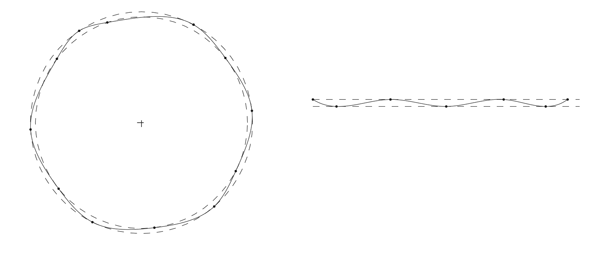Reference geometry
Variable Section Sweep
Layers & visibility
Adv. Rounds
Mathematical control
Advanced Patterns
Draft & Split plane Trim
Geometry from 2D graphics
Model analysis
Accuracy
Skeleton based surfacing:
Model Analysis
Section Curvature
Splines
Boundary Blend
Construction and manipulation
Trim, Merge & Solidify
3sided surfaces
Offset Surfaces
Accuracy
When discussing the manufacture of a part DO NOT say it has to "very accurate" or "exact", there is no such dimension as 10mm, a part is made to 10mm plus or minus a certain Tolerance that is its Accuracy.
As well as considering simple dimensional tolerance of a feature, say plus or minus 0.01mm on a length or diameter, we also have to consider the Geometric Tolerance of a feature - how flat or how round something is, what the envelope of deviation is - Wiki discussion

Making something to a high tolerance is not necessarily a good thing - high tolerance costs money and artifacts should be made to an appropriate tolerance - we would not build a shed to the same tolerance as we would manufacture an analogue wrist watch!
The main reasons for being aware of accuracy in the virtual CAD model are regeneration times and interaction between parts with differing accuracies. The real world impact of accuracy setting would only come into play if you worked with, for example. very large parts or very high accuracy (aerospace) parts.
ProE provides two methods to define accuracy: relative and absolute - the default is relative accuracy.
Relative Accuracy - the part accuracy is Relative to the greatest dimension of the part. The default setting is 0.001, therefore the accuracy of our 2m by 1m shed would be 2mm and a 3mm part in our watch would be .003mm
But what if you have a 10mm cube part which has a long thin tube protruding from the side? If the tube was 1m long your Relative accuracy would be 1mm - not good for the 10mm lump on the end. This may be a situation where you switch to;
Absolute Accuracy - an absolute figure which all features are calculated to. In the above scenario we may switch to an Absolute accuracy of .01mm
Another factor to consider if your thinking of making large components to a high accuracy is Thermal Expansion - a 1m length of aluminium will increase its length by 0.23mm if its temperature is raised 10 degrees. Environmental conditions need to be conditions with reference to tolerancing scheme.
